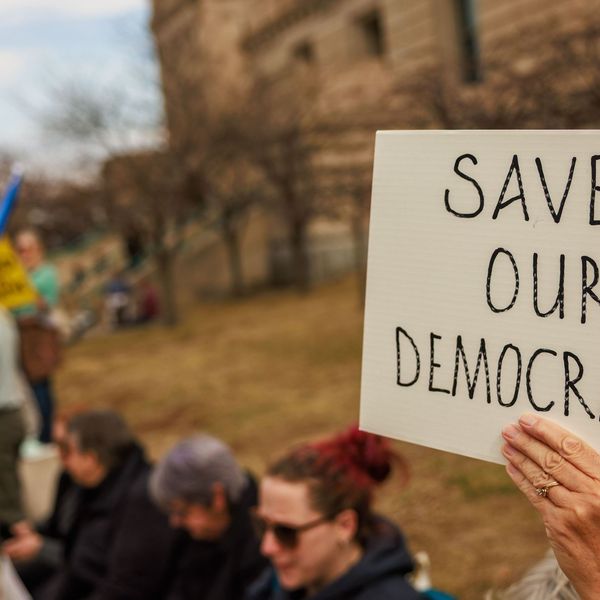
Protesters demonstrate outside the U.S. Supreme Court as justices considered partisan gerrymandering. (Photo: Shawn Thew/EPA-EFE)
'A Damn Shame': Ohio Senate Approves 'Extreme' Gerrymandered Map Favoring GOP
"And to think, Ohio lawmakers had the opportunity to restore voters' faith in the democratic process."
Ohio's Republican-dominated Senate on Tuesday approved a congressional district map that critics say is designed to benefit the GOP--a move that sparked swift criticism of the state's lawmakers and bolstered demands for Congress to pass federal legislation to protect voting rights and outlaw gerrymandering.
Unveiled late Monday by Republican state lawmakers, the new map was advanced by the Ohio Senate Local Government and Elections Committee before being approved by the full upper chamber. It still needs approval from the Ohio House and GOP Gov. Mike DeWine.
"Announcing a new map late in the evening, just hours before a vote, with no opportunity or possibility even for in-depth analysis or discussion, is disrespectful," said Catherine Turcer, executive director of Common Cause Ohio, after the first vote.
\u201cAnd to think, Ohio lawmakers had the opportunity to restore voters' faith in the democratic process.\u201d— ACLU of Ohio (@ACLU of Ohio) 1637084584
"In 2018, Ohio voters overwhelmingly approved transparent and bipartisan mapmaking with meaningful opportunities for public input," Turcer added. "Ohio voters deserve better."
"It's incredibly disheartening," the Common Cause Ohio leader told The Columbus Dispatch.
\u201cOhio voters overwhelmingly supported redistricting reform in 2018. That's why @CommonCauseOhio Executive Director @CatherineTurcer says the state's less than transparent process is "incredibly disheartening." #FairMaps https://t.co/DLumKC7tzz\u201d— Common Cause (@Common Cause) 1637074366
Deidra Reese, statewide coordinator of the Ohio Unity Coalition, similarly noted that the schedule meant lawmakers had little time to hear from opponents of the map.
"I am disappointed that they didn't hear the pleas from hundreds of Ohioans for districts that are fair and representative of the people," Reese said, agreeing that "we deserve better" and calling on Ohio lawmakers to "reject this plan."
Ohio Senate Republicans highlight that the new map would only divide 12 counties and keep seven of the state's eight biggest cities in single districts. They also claim seven of Ohio's 15 districts would be competitive between Democratic and GOP candidates.
However, analyses suggest the new boundaries would only benefit Democrats in a few districts. As Cleveland.com detailed Tuesday:
The map as designed favors Republicans to win a 12-3 share of Ohio's congressional seats, according to modeling from Dave's Redistricting App, a widely used redistricting site. DRA rates the map as "OK" on compactness, competitiveness, and community splitting. It rates "very bad" for political proportionality, worse than the current map, which awards Republicans a 12-4 share.
The new map's 12-3 breakdown includes two toss-up districts. One, which includes Democratic Toledo Rep. Marcy Kaptur's district, leans slightly Republican, while another, incorporating outgoing GOP Rocky River Rep. Anthony Gonzalez's district, leans slightly Democratic. A district in the Cincinnati area represented by GOP Rep. Steve Chabot leans three points Republican, but Sen. Rob McColley, a Republican who is sponsoring the map plan, said President Joe Biden narrowly won the district in 2020.
Although former President Donald Trump remains committed to his "Big Lie" about the 2020 election, Biden won the national contest. However, despite Biden doing well in Ohio's major cities, Trump secured the Midwestern state by more than eight points.
Mother Jones' Ari Berman, author of Give Us the Ballot: The Modern Struggle for Voting Rights in America, said Tuesday that the "extreme gerrymandered congressional map" gives Republicans 80% of seats in a state where Trump won with 53% of the vote.
Responding to Berman's tweet, Nina Turner--a former Cleveland City Council member, Ohio state senator, and U.S. House candidate--said, "This is a damn shame."
\u201cThis is a damn shame.\u201d— Nina Turner (@Nina Turner) 1637094172
The Ohio House Government Oversight Committee is set to consider the map Wednesday morning. The full chamber has sessions scheduled for Wednesday and Thursday. Neither chamber is scheduled to meet next week, and the rapidly approaching deadline to finish the map is the end of the month.
The Dispatch explained that what happens in the state House could impact how long the map is in effect, if approved by all necessary parties. For the map to last a decade, it needs approval from 60% of lawmakers in each chamber and 33% of Democrats, which "amounts to 12 Democrats in the House and three in the Senate."
"Nobody wants a four-year map," said Senate Minority Leader Kenny Yuko (D-25), telling the newspaper he is aiming for a compromise. "If it's doable, if it's palatable, then I'll whip my caucus."
\u201cNo matter what happened over the past 5 election cycles (red waves, blue waves, odd trends, inspiring candidates, unpopular candidates, COVID, etc.,) the map performed *exactly* as it's architects intended.\n\nWE DO NOT WANT THE STATUS QUO TO CONTINUE. \n\n#FairMaps no more, no less.\u201d— ACLU of Ohio (@ACLU of Ohio) 1637098545
The battle over the map in Ohio--mirroring other GOP-controlled states--comes as congressional Democrats have been fighting to pass various voting rights legislation.
Earlier this month, all U.S. Senate Republicans expect Lisa Murkowski of Alaska prevented a floor debate on the John R. Lewis Voting Rights Advancement Act, which came after the evenly divided chamber's GOP caucus twice blocked a package called the For the People Act as well as a later compromise bill, the Freedom to Vote Act.
That GOP obstruction as well as state Republican lawmakers' voter suppression bills and gerrymandering efforts this year have added fuel to calls for Senate Democrats to reform or even fully abolish the filibuster so they can quickly send an election reform bill to Biden's desk.
An Urgent Message From Our Co-Founder
Dear Common Dreams reader, The U.S. is on a fast track to authoritarianism like nothing I've ever seen. Meanwhile, corporate news outlets are utterly capitulating to Trump, twisting their coverage to avoid drawing his ire while lining up to stuff cash in his pockets. That's why I believe that Common Dreams is doing the best and most consequential reporting that we've ever done. Our small but mighty team is a progressive reporting powerhouse, covering the news every day that the corporate media never will. Our mission has always been simple: To inform. To inspire. And to ignite change for the common good. Now here's the key piece that I want all our readers to understand: None of this would be possible without your financial support. That's not just some fundraising cliche. It's the absolute and literal truth. We don't accept corporate advertising and never will. We don't have a paywall because we don't think people should be blocked from critical news based on their ability to pay. Everything we do is funded by the donations of readers like you. Will you donate now to help power the nonprofit, independent reporting of Common Dreams? Thank you for being a vital member of our community. Together, we can keep independent journalism alive when it’s needed most. - Craig Brown, Co-founder |
Ohio's Republican-dominated Senate on Tuesday approved a congressional district map that critics say is designed to benefit the GOP--a move that sparked swift criticism of the state's lawmakers and bolstered demands for Congress to pass federal legislation to protect voting rights and outlaw gerrymandering.
Unveiled late Monday by Republican state lawmakers, the new map was advanced by the Ohio Senate Local Government and Elections Committee before being approved by the full upper chamber. It still needs approval from the Ohio House and GOP Gov. Mike DeWine.
"Announcing a new map late in the evening, just hours before a vote, with no opportunity or possibility even for in-depth analysis or discussion, is disrespectful," said Catherine Turcer, executive director of Common Cause Ohio, after the first vote.
\u201cAnd to think, Ohio lawmakers had the opportunity to restore voters' faith in the democratic process.\u201d— ACLU of Ohio (@ACLU of Ohio) 1637084584
"In 2018, Ohio voters overwhelmingly approved transparent and bipartisan mapmaking with meaningful opportunities for public input," Turcer added. "Ohio voters deserve better."
"It's incredibly disheartening," the Common Cause Ohio leader told The Columbus Dispatch.
\u201cOhio voters overwhelmingly supported redistricting reform in 2018. That's why @CommonCauseOhio Executive Director @CatherineTurcer says the state's less than transparent process is "incredibly disheartening." #FairMaps https://t.co/DLumKC7tzz\u201d— Common Cause (@Common Cause) 1637074366
Deidra Reese, statewide coordinator of the Ohio Unity Coalition, similarly noted that the schedule meant lawmakers had little time to hear from opponents of the map.
"I am disappointed that they didn't hear the pleas from hundreds of Ohioans for districts that are fair and representative of the people," Reese said, agreeing that "we deserve better" and calling on Ohio lawmakers to "reject this plan."
Ohio Senate Republicans highlight that the new map would only divide 12 counties and keep seven of the state's eight biggest cities in single districts. They also claim seven of Ohio's 15 districts would be competitive between Democratic and GOP candidates.
However, analyses suggest the new boundaries would only benefit Democrats in a few districts. As Cleveland.com detailed Tuesday:
The map as designed favors Republicans to win a 12-3 share of Ohio's congressional seats, according to modeling from Dave's Redistricting App, a widely used redistricting site. DRA rates the map as "OK" on compactness, competitiveness, and community splitting. It rates "very bad" for political proportionality, worse than the current map, which awards Republicans a 12-4 share.
The new map's 12-3 breakdown includes two toss-up districts. One, which includes Democratic Toledo Rep. Marcy Kaptur's district, leans slightly Republican, while another, incorporating outgoing GOP Rocky River Rep. Anthony Gonzalez's district, leans slightly Democratic. A district in the Cincinnati area represented by GOP Rep. Steve Chabot leans three points Republican, but Sen. Rob McColley, a Republican who is sponsoring the map plan, said President Joe Biden narrowly won the district in 2020.
Although former President Donald Trump remains committed to his "Big Lie" about the 2020 election, Biden won the national contest. However, despite Biden doing well in Ohio's major cities, Trump secured the Midwestern state by more than eight points.
Mother Jones' Ari Berman, author of Give Us the Ballot: The Modern Struggle for Voting Rights in America, said Tuesday that the "extreme gerrymandered congressional map" gives Republicans 80% of seats in a state where Trump won with 53% of the vote.
Responding to Berman's tweet, Nina Turner--a former Cleveland City Council member, Ohio state senator, and U.S. House candidate--said, "This is a damn shame."
\u201cThis is a damn shame.\u201d— Nina Turner (@Nina Turner) 1637094172
The Ohio House Government Oversight Committee is set to consider the map Wednesday morning. The full chamber has sessions scheduled for Wednesday and Thursday. Neither chamber is scheduled to meet next week, and the rapidly approaching deadline to finish the map is the end of the month.
The Dispatch explained that what happens in the state House could impact how long the map is in effect, if approved by all necessary parties. For the map to last a decade, it needs approval from 60% of lawmakers in each chamber and 33% of Democrats, which "amounts to 12 Democrats in the House and three in the Senate."
"Nobody wants a four-year map," said Senate Minority Leader Kenny Yuko (D-25), telling the newspaper he is aiming for a compromise. "If it's doable, if it's palatable, then I'll whip my caucus."
\u201cNo matter what happened over the past 5 election cycles (red waves, blue waves, odd trends, inspiring candidates, unpopular candidates, COVID, etc.,) the map performed *exactly* as it's architects intended.\n\nWE DO NOT WANT THE STATUS QUO TO CONTINUE. \n\n#FairMaps no more, no less.\u201d— ACLU of Ohio (@ACLU of Ohio) 1637098545
The battle over the map in Ohio--mirroring other GOP-controlled states--comes as congressional Democrats have been fighting to pass various voting rights legislation.
Earlier this month, all U.S. Senate Republicans expect Lisa Murkowski of Alaska prevented a floor debate on the John R. Lewis Voting Rights Advancement Act, which came after the evenly divided chamber's GOP caucus twice blocked a package called the For the People Act as well as a later compromise bill, the Freedom to Vote Act.
That GOP obstruction as well as state Republican lawmakers' voter suppression bills and gerrymandering efforts this year have added fuel to calls for Senate Democrats to reform or even fully abolish the filibuster so they can quickly send an election reform bill to Biden's desk.
Ohio's Republican-dominated Senate on Tuesday approved a congressional district map that critics say is designed to benefit the GOP--a move that sparked swift criticism of the state's lawmakers and bolstered demands for Congress to pass federal legislation to protect voting rights and outlaw gerrymandering.
Unveiled late Monday by Republican state lawmakers, the new map was advanced by the Ohio Senate Local Government and Elections Committee before being approved by the full upper chamber. It still needs approval from the Ohio House and GOP Gov. Mike DeWine.
"Announcing a new map late in the evening, just hours before a vote, with no opportunity or possibility even for in-depth analysis or discussion, is disrespectful," said Catherine Turcer, executive director of Common Cause Ohio, after the first vote.
\u201cAnd to think, Ohio lawmakers had the opportunity to restore voters' faith in the democratic process.\u201d— ACLU of Ohio (@ACLU of Ohio) 1637084584
"In 2018, Ohio voters overwhelmingly approved transparent and bipartisan mapmaking with meaningful opportunities for public input," Turcer added. "Ohio voters deserve better."
"It's incredibly disheartening," the Common Cause Ohio leader told The Columbus Dispatch.
\u201cOhio voters overwhelmingly supported redistricting reform in 2018. That's why @CommonCauseOhio Executive Director @CatherineTurcer says the state's less than transparent process is "incredibly disheartening." #FairMaps https://t.co/DLumKC7tzz\u201d— Common Cause (@Common Cause) 1637074366
Deidra Reese, statewide coordinator of the Ohio Unity Coalition, similarly noted that the schedule meant lawmakers had little time to hear from opponents of the map.
"I am disappointed that they didn't hear the pleas from hundreds of Ohioans for districts that are fair and representative of the people," Reese said, agreeing that "we deserve better" and calling on Ohio lawmakers to "reject this plan."
Ohio Senate Republicans highlight that the new map would only divide 12 counties and keep seven of the state's eight biggest cities in single districts. They also claim seven of Ohio's 15 districts would be competitive between Democratic and GOP candidates.
However, analyses suggest the new boundaries would only benefit Democrats in a few districts. As Cleveland.com detailed Tuesday:
The map as designed favors Republicans to win a 12-3 share of Ohio's congressional seats, according to modeling from Dave's Redistricting App, a widely used redistricting site. DRA rates the map as "OK" on compactness, competitiveness, and community splitting. It rates "very bad" for political proportionality, worse than the current map, which awards Republicans a 12-4 share.
The new map's 12-3 breakdown includes two toss-up districts. One, which includes Democratic Toledo Rep. Marcy Kaptur's district, leans slightly Republican, while another, incorporating outgoing GOP Rocky River Rep. Anthony Gonzalez's district, leans slightly Democratic. A district in the Cincinnati area represented by GOP Rep. Steve Chabot leans three points Republican, but Sen. Rob McColley, a Republican who is sponsoring the map plan, said President Joe Biden narrowly won the district in 2020.
Although former President Donald Trump remains committed to his "Big Lie" about the 2020 election, Biden won the national contest. However, despite Biden doing well in Ohio's major cities, Trump secured the Midwestern state by more than eight points.
Mother Jones' Ari Berman, author of Give Us the Ballot: The Modern Struggle for Voting Rights in America, said Tuesday that the "extreme gerrymandered congressional map" gives Republicans 80% of seats in a state where Trump won with 53% of the vote.
Responding to Berman's tweet, Nina Turner--a former Cleveland City Council member, Ohio state senator, and U.S. House candidate--said, "This is a damn shame."
\u201cThis is a damn shame.\u201d— Nina Turner (@Nina Turner) 1637094172
The Ohio House Government Oversight Committee is set to consider the map Wednesday morning. The full chamber has sessions scheduled for Wednesday and Thursday. Neither chamber is scheduled to meet next week, and the rapidly approaching deadline to finish the map is the end of the month.
The Dispatch explained that what happens in the state House could impact how long the map is in effect, if approved by all necessary parties. For the map to last a decade, it needs approval from 60% of lawmakers in each chamber and 33% of Democrats, which "amounts to 12 Democrats in the House and three in the Senate."
"Nobody wants a four-year map," said Senate Minority Leader Kenny Yuko (D-25), telling the newspaper he is aiming for a compromise. "If it's doable, if it's palatable, then I'll whip my caucus."
\u201cNo matter what happened over the past 5 election cycles (red waves, blue waves, odd trends, inspiring candidates, unpopular candidates, COVID, etc.,) the map performed *exactly* as it's architects intended.\n\nWE DO NOT WANT THE STATUS QUO TO CONTINUE. \n\n#FairMaps no more, no less.\u201d— ACLU of Ohio (@ACLU of Ohio) 1637098545
The battle over the map in Ohio--mirroring other GOP-controlled states--comes as congressional Democrats have been fighting to pass various voting rights legislation.
Earlier this month, all U.S. Senate Republicans expect Lisa Murkowski of Alaska prevented a floor debate on the John R. Lewis Voting Rights Advancement Act, which came after the evenly divided chamber's GOP caucus twice blocked a package called the For the People Act as well as a later compromise bill, the Freedom to Vote Act.
That GOP obstruction as well as state Republican lawmakers' voter suppression bills and gerrymandering efforts this year have added fuel to calls for Senate Democrats to reform or even fully abolish the filibuster so they can quickly send an election reform bill to Biden's desk.

